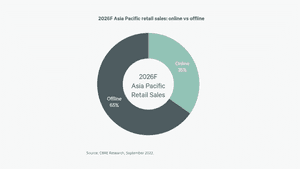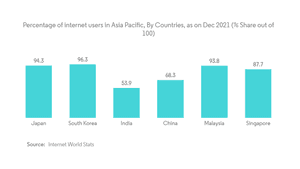APAC is eCommerce Pro: Here is How Retailers Can Win
Sector: Digital Commerce
Author: Nisarg Mehta
Date Published: 03/14/2023

Contents
The growth of eCommerce has been phenomenal globally, and the Asia-Pacific region is no exception. The omnipresence of internet access and the rapid delivery of goods have made online shopping a convenient option for consumers.
Similarly, the rise of internet connectivity and penetration in the Asia-Pacific region has led to a digital transformation in various industries, including retail. With the retail sector being a significant source of income for the region, it was only natural for it to adapt to the digital age.
The eCommerce market in the Asia-Pacific has experienced remarkable growth, with various markets contributing significantly to global eCommerce revenue.
According to Euromonitor International, a global market research firm, eCommerce sales in the Asia Pacific region are expected to experience a significant increase, reaching a whopping $2 trillion by 2025, which represents nearly double the current figure.
Moreover, according to another report on Asia Pacific Omnichannel Retail, the region is expected to maintain its lead in eCommerce growth, surpassing other parts of the world. In fact, it is projected that Asia Pacific will generate 90% of global eCommerce growth from 2021 to 2026.
What’s more exciting is that online retail will contribute 35% by 2026, which is a significant share.

Let’s get more into the retail customer behavior in the APAC region
APAC Retail Market Outlook
The following traits hint that eCommerce will continue to flourish in the APAC region:
Growing Disposable Income
One of the key drivers of eCommerce growth in the APAC region is the rise of the middle class, which has resulted in higher levels of disposable income. This trend, in turn, has led to increased internet penetration and a high number of smartphone users throughout the region.

As a result of better connectivity, consumers in Asia have become more accustomed to online shopping and are shifting away from physical retail.
M-Commerce Trend
The growth of eCommerce in the region has also been boosted by social media, which has enabled online retailers to reach wider audiences. By creating direct links to online stores and product pages, social media platforms have facilitated an opportunity for retailers to advertise and sell goods online.
In addition, some social media sites have evolved into online marketplaces, allowing users to buy products without having to leave the platform. Mobile commerce (m-commerce) has also experienced a surge in popularity, particularly in Indonesia, Thailand, and the Philippines, where it has seen the highest levels of adoption.
Government Support
In response to the notable expansion of eCommerce in the region, governments have initiated the regulation of laws and policies aimed at enhancing the growth of eCommerce businesses by creating favorable conditions.
For instance, in 2019, the Government of India drafted an eCommerce policy to regulate the growth of eCommerce in the nation. The policy focuses on consumer data protection, data localization, intellectual property, and competition. It allows 100% foreign direct investment in B2B eCommerce and 100% FDI under the automatic route for the marketplace model of B2C eCommerce.
Top APAC eCommerce Marketplaces
The region encompasses a diverse range of countries with different levels of development and market dynamics. Based on that, here are the top three eCommerce players in the APAC region:
1. Alibaba Group
Alibaba is the largest eCommerce player not only in the APAC region but globally as well. The eCommerce giant had 24% of the global eCommerce market share in 2021. Its online marketplaces, including Taobao and Tmall, facilitate transactions between buyers and sellers of a wide range of products, from consumer goods to industrial equipment. In addition, Alibaba provides a range of digital services such as cloud computing, digital payments, and logistics, making it a comprehensive eCommerce ecosystem.
2. Amazon
Amazon is a major player in eCommerce, with a strong presence in the US and APAC economies. Its online retail platform offers various products and services, including books, electronics, apparel, and cloud computing. Amazon has also been expanding its digital services, such as Amazon Prime, which provides subscribers with free shipping, streaming of movies, music, and other benefits.
3. JD.com
JD.com, aka Jingdong, is a leading eCommerce company in China, offering a broad range of products, including electronics, apparel, and fresh food. The company has a robust logistics network and a reputation for speedy delivery, often within one day. JD.com has been expanding globally and has partnered with several retailers and eCommerce companies in Southeast Asia and Europe to expand its reach.
It’s worth noting that there are other major eCommerce players in the APAC region, such as Rakuten in Japan, Shopee in Southeast Asia, and eBay in Australia and New Zealand, among others.
The Going Online Roadmap for Retailers in APAC Region
Given the market’s lucrativeness, it’s more critical than ever for retailers like you to go online and leverage an omnichannel strategy. Even if you’re an online-only retailer, now is the high time to get started.
Here is how you can go online:
1. Assess Your Business
Assessing your readiness for eCommerce is an essential step in moving forward to online retailing. It involves analyzing your business’s internal readiness to go online, including the existing infrastructure, supply chain, and logistics. It also includes assessing external factors such as market demand and competition.
The assessment ensures that your business can effectively leverage the benefits of going online and avoid potential challenges.
For example, a retailer with limited warehouse space or outdated inventory management systems may face challenges in efficiently fulfilling online orders.
To assess your readiness for eCommerce, you should consider the following factors:
- Business operations – Assess the capabilities of your existing infrastructure, supply chain, and logistics to determine their readiness to support eCommerce. For example, if your business relies on manual processes for order fulfillment, you may need to invest in automation technologies to handle the increased volume of online orders.
- Market demand – Evaluate the market demand for your products or services online. For example, if your business is in the fashion industry, there may be a higher demand for online shopping compared to a business that sells industrial equipment.
- Customer expectations – Evaluate customer expectations for online shopping, such as the availability of delivery options, payment methods, and customer service. For example, if your business does not offer online tracking or returns, you may need to adjust your eCommerce strategy to meet customer expectations.
2. Choose an eCommerce Platform
Defining your eCommerce strategy is critical to ensure that your online presence is aligned with your overall business objectives and enables you to achieve your desired outcomes. A well-defined eCommerce strategy can help you identify your target customers, product offerings, pricing strategy, and marketing channels.
To define your eCommerce strategy, you should consider the following factors:
- Product and service offerings – Identify the products and services that you plan to offer online.
- Target customers – Identify your target customers and where you can reach them. For example, if your business targets young adults, you may focus on social media marketing channels.
- Pricing strategy – Determine your pricing strategy for your products and services. For example, you may offer discounts for online purchases or free shipping for certain order sizes.
- Marketing channels – Determine the marketing channels that you will use to promote your eCommerce store. For example, you may use influencer marketing, email marketing, or search engine optimization (SEO).
- Sales and fulfillment – Determine how you will fulfill online orders and manage customer service. For example, you may use a third-party logistics provider or in-house fulfillment.
3. Set Up an Online Store
Next is setting up an eCommerce website or online store where customers can browse your products and make purchases.
Developing your online store is critical to providing customers with a seamless and convenient online shopping experience. Your online shop should be easy to navigate, visually appealing, and provide all the necessary information about your products or services.
To develop your online store, you should consider the following factors:
- Choose an eCommerce platform – Select an eCommerce platform that meets your business needs and budget. For example, you may use Shopify, WooCommerce, or Adobe Commerce.
- Design UI/UX – Design your online store with a user-friendly interface and a visually appealing layout. Consider the customer journey and ensure that the online store is easy to navigate.
- Product catalog – Build a product catalog that includes product images, descriptions, prices, and availability. Organize your products into categories and subcategories to make them easy to find.
- Payment options – Offer multiple payment options, such as credit card, debit card, PayPal, and other payment gateways.
- Delivery logistics – Establish a delivery logistics system that ensures timely and efficient delivery of products to customers. Consider factors such as shipping rates, delivery times, and tracking options.
- Security and privacy – Implement security measures to protect customer information and secure online transactions.
4. Market Your Online Store
Then comes promoting your online store and reaching out to your target customers to generate awareness and drive traffic to your online store.
Marketing your online store is critical to attracting and retaining customers and increasing your online sales. Your marketing strategy should include a mix of paid and organic marketing tactics that are aligned with your business objectives and target customer preferences.
To market your online store, you should consider the following channels:
- SEO – Optimize your online store for search engines to increase visibility and traffic. This involves researching and using relevant keywords, optimizing your website content and structure, and building high-quality backlinks.
- Social media marketing – Use social media platforms to reach out to your target customers and generate awareness about your online store. Consider the social media platforms that your target customers prefer and develop engaging and informative content that resonates with them.
- Email marketing – Use email marketing to engage with your customers and promote your products or services. Build an email list by offering incentives or rewards for subscribing to your newsletter and send regular email campaigns that provide value to your subscribers.
- Paid advertising – Use paid advertising such as Google Ads or social media advertising to increase the visibility of your online store and drive targeted traffic.
- Influencer marketing – Partner with influencers or bloggers to promote your products or services and reach out to a wider audience. Consider the influencers that your target customers follow and work with them to create engaging and informative content that promotes your online store.
5. Manage Customer Relationships
When you’ve established your eCommerce store, you should start using data analytics and customer feedback to improve your store’s performance and customer experience.
Optimizing your online store is critical to providing a seamless and personalized online shopping experience. By analyzing data and customer feedback, you can identify areas of improvement and make the required changes to enhance your online store’s performance.
To optimize your online store, you should consider the following factors:
- Website analytics – Use website analytics tools such as Google Analytics to track website traffic, user behavior, and conversion rates. Analyze the data to identify areas of improvement and make changes that enhance your website’s performance.
- Customer feedback – Collect feedback from your customers to understand their preferences and identify areas of improvement. Use customer feedback to improve your product offerings, pricing strategy, and customer service.
- User experience – Continuously improve your online store’s UX by identifying and addressing usability issues. This includes improving the website’s speed, making it mobile-friendly, and providing a seamless checkout process.
- Personalization – Use data analytics and customer feedback to personalize your online store’s content and offerings. This includes recommending products based on previous purchases or browsing behavior and tailoring marketing messages to specific customer segments.
- A/B testing – Conduct A/B testing to compare the performance of different website elements, such as product descriptions, images, or page layout. Use the results to identify the best-performing elements and make changes that enhance your online store’s performance.
How Can You Build Your eCommerce Store?
The eCommerce market in the APAC region will continue to flourish as the middle class keeps getting more disposable income. Moreover, the governments in this region are upfront supportive of the new age of retailing.
Hence, it is imperative for retailers in the APAC region to have a digital strategy that can help them tap into a broader customer segment. However, building an eCommerce store can be a challenge for retailers.
This is where eCommerce solution experts like Techtic come in. We have helped over a dozen of retailers worldwide to go online and provide an omnichannel experience to their customers. We have expertise in eCommerce platforms like Shopify, BigCommerce, Adobe Commerce, etc.
Here is how we’ve helped Dome to achieve digital transformation – Read Dome Case Study
Latest Tech Insights!
Join our newsletter for the latest updates, tips, and trends.



